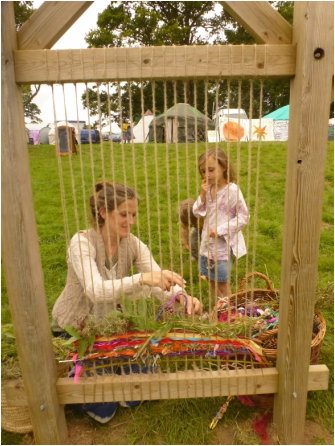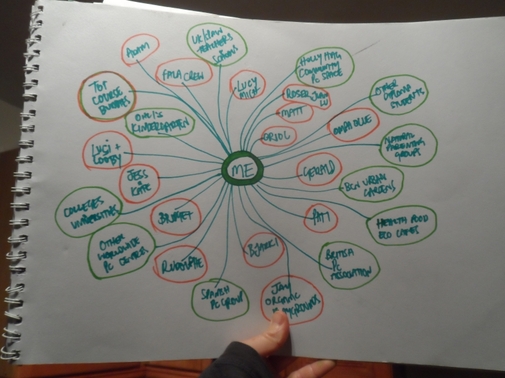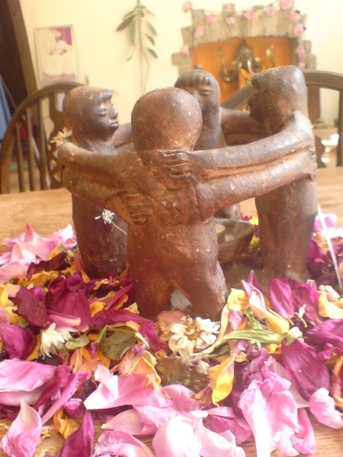Now for the design
Course outline

So here is my final design section. To get to this point I have separated my session ideas and resources into sections relevant to each area of permaculture, with ideas from my research and including the ideas generated from my micro-teach class. As well as putting them on here for this project, I'm also building up a paper version of all of this, putting all of my ideas, lesson plans, including blank templates to fill in later, and photocopies of any supporting or inspiring material that I come across. This catalogue of ideas will keep expanding and growing as I come across more information and ideas.
This should then be really useful for me to keep on designing new lesson plans and adapting and adding to them as time goes by, especially if I'm working in areas without much power or internet access (like our Spanish home).
Along with my guidelines for hosting courses for children that I have developed in the earlier sections of this project I feel confident that I can create many different designs of courses from this project's work. And when I do host my first children's permaculture course, as I'm sure I will in the coming months, I will upload details of it here.
Below I've made just a brief outline of a possible 3 day children's course, without going into too much detail, just to give an idea of what I may include. Since there are so many practical factors that would influence the selection of lessons that I choose to build a course, such as location (does the space have an outdoor area we can use?) age range of children, will there also be adults present, (as part of a full family course) or will it just be for children, etc etc, until I have a specific course planned I won't be able to plan exactly what will be covered. But I imagine it will go something like this.
This should then be really useful for me to keep on designing new lesson plans and adapting and adding to them as time goes by, especially if I'm working in areas without much power or internet access (like our Spanish home).
Along with my guidelines for hosting courses for children that I have developed in the earlier sections of this project I feel confident that I can create many different designs of courses from this project's work. And when I do host my first children's permaculture course, as I'm sure I will in the coming months, I will upload details of it here.
Below I've made just a brief outline of a possible 3 day children's course, without going into too much detail, just to give an idea of what I may include. Since there are so many practical factors that would influence the selection of lessons that I choose to build a course, such as location (does the space have an outdoor area we can use?) age range of children, will there also be adults present, (as part of a full family course) or will it just be for children, etc etc, until I have a specific course planned I won't be able to plan exactly what will be covered. But I imagine it will go something like this.
Sample course outline for a 3 day child's permaculture course
|
Day 1
9-9.30 Opening circle 9.30-10.30 Parachute and outdoor games. 'Meet a tree' blindfold game 10.30-11 Break 11-12.30 Pond dipping and insect ID 12.30-1.30 Lunch 1.30-3 Design and make a bug house in a group 3.30-5 Optional shelter building in woods and group singing |
Day 2
9-10.30 Looking for patterns in nature, and using our bodies to copy patterns, both individual and in a group 10.30-11 Break 11-12.30 Wild foraging and cordial making 12.30-1.30 Lunch 1.30-3 Building fairy houses from stones/sticks/clay 3.30-5 Optional natural dying and storytelling |
Day 3
9-10.30 Animal tracking and treasure hunt 10.30-11 Break 11-12.30 Inputs and outputs game 12.30-1.30 Lunch 1.30-3 Making seed bombs, bird feeders and planting seeds to take away with us 3.30-5 Optional giant Earth loom weaving in the trees 5pm Closing circle |
Below is the link to my page of ideas under the relevant section. I will be using this page to create the lesson plans from. It will be an on-going task to write up the lesson plans, as it is much more manageable to write them up as I need them for each course that I host. In this way, for the first few courses I host there will be some preparation time involved with this, but that will get less as I can instead refer back to the plans I have already made.
To see the list of session ideas so far please click the link below.
Lesson plans
After looking at many different lesson plan templates, I have adapted several that I have found to make one that I feel fits the best with the kind of classes that I will be running.
I've tried to include everything on the plan so that they can be used in many different circumstances. Hopefully they are easy for others to understand, whether they be co-teachers, or others who access the resources on-line. It'll also mean that they are highly adaptable to use in school environments so they can be used for teaching school classes, only needing to link them in the right area of the school curriculum.
As the main intention of this project was to create lesson plans for teaching family permaculture courses, the age range of the class would most likely be varied and could be anything between 3 to 16 years old. I think that almost all of the ideas for classes can be adapted to suit a whole range of ages and abilities. I also feel that to keep an inclusive family feeling to any course that I host, I would like the activities to be for all, and responsibilities and more complex aspects of any activity can always be given to whoever is ready. But for those classes that are separated by age, such as in school classes, I have specified the age that the class as it is written on the plan is appropriate to. I've also left a space for notes at the end of each plan so that ideas can be recorded for either simplifying the class or making it more in depth and mature to suit different ages.
Here you can see the template I have made.
I've tried to include everything on the plan so that they can be used in many different circumstances. Hopefully they are easy for others to understand, whether they be co-teachers, or others who access the resources on-line. It'll also mean that they are highly adaptable to use in school environments so they can be used for teaching school classes, only needing to link them in the right area of the school curriculum.
As the main intention of this project was to create lesson plans for teaching family permaculture courses, the age range of the class would most likely be varied and could be anything between 3 to 16 years old. I think that almost all of the ideas for classes can be adapted to suit a whole range of ages and abilities. I also feel that to keep an inclusive family feeling to any course that I host, I would like the activities to be for all, and responsibilities and more complex aspects of any activity can always be given to whoever is ready. But for those classes that are separated by age, such as in school classes, I have specified the age that the class as it is written on the plan is appropriate to. I've also left a space for notes at the end of each plan so that ideas can be recorded for either simplifying the class or making it more in depth and mature to suit different ages.
Here you can see the template I have made.
And here are some links to some of the lesson plans I have started to create.
| dance_and_sing_for_the_seasons.doc | |
| File Size: | 32 kb |
| File Type: | doc |
| rainy_day_dance.doc | |
| File Size: | 34 kb |
| File Type: | doc |
When I have built up this lesson plan resource I will be wanting to make them more easily accessible to others who may want to use them. When I have finished this diploma I will be making a new teaching website, so I will upload them there.
Developing permaculture in schools - reaching out into my communityThe part time work I began whilst working on this project has developed into the creation of my own company, and now, 3 months after it's beginning, I am taking bookings for school projects all around the country. I set up Organic Playgrounds out of a desire to find my way into schools to share elements of permaculture. Starting off with Earth looms and living willow structures, I am now going further into playground design and after school classes. All of this has come with the development of this project. You can see my website at www.organicplaygrounds.com and on facebook under Organic Playgrounds.
Natural successionSo where does this project lead me to next? I feel that I have been through a great deal of personal learning and growth through the development of this project. I have begun to explore in more depth issues of childhood education and development, things which are very close to my heart, raising a child whilst being very aware of the shortfalls of our current mainstream education systems, and their lack of understanding or respect for each child's personal learning and emotional needs. I have seen some of the areas that I would like to develop my knowledge, so a plan for extended learning seems to be coming to life for me.
Using this project as a stepping stone, these are some of the things that I would like to move onto in the coming months and years, though I'm sure that this list will continue to grow.. |
Guilds and companion plants
|
Like any garden design, creating a harmonic system of companions that work well together brings great benefits for the health and success of the garden. And I know that I work best when I have the right companions by my side, together we flourish much more than we often can alone. So this got me to thinking about who my companion plants are for this work with childhood permaculture education. I have made a picture showing which folks I can imagine creating great things with. Orange circles are friends, green circles are organisations or groups, making up my inner and outer circles.
|
Energy flows -
energy in use and embodied energy
I've been thinking how I can best cycle all of the energy within this system of creating my courses, to make sure that none of it is lost, and it is all harvested and channelled back in to create the most benefit. Thinking of the embodied energy within a course or workshop, I want to make sure that I use my time efficiently when creating the course plans, for example building up my resources as and when they are needed so that I don't waste any time doing things that don't get used. And considering the energy created by hosting the course itself, I'd like to make sure that I channel that back into the whole system by sharing what I learn with my community and co-teachers, consistently improving my lesson plans, and re-designing better courses each time.
I can also re-cycle this energy into my personal life with Ohli, as I can capture the energy from all of the ideas and activities, and deepening research and learning into childhood development, and use this to positively impact our family life.
I would also like to keep sharing my work through websites, as they reach so many people in such a good way. After this diploma is finished and this website is no longer being updated, I'd like to create another permaculture based one to use as a space to share the output of energy created through hosting these courses. By sharing lesson ideas, photos and possibly a blog page I can keep expanding the reach of all that I am doing.
I can also re-cycle this energy into my personal life with Ohli, as I can capture the energy from all of the ideas and activities, and deepening research and learning into childhood development, and use this to positively impact our family life.
I would also like to keep sharing my work through websites, as they reach so many people in such a good way. After this diploma is finished and this website is no longer being updated, I'd like to create another permaculture based one to use as a space to share the output of energy created through hosting these courses. By sharing lesson ideas, photos and possibly a blog page I can keep expanding the reach of all that I am doing.
You can move to the project evaluation here



